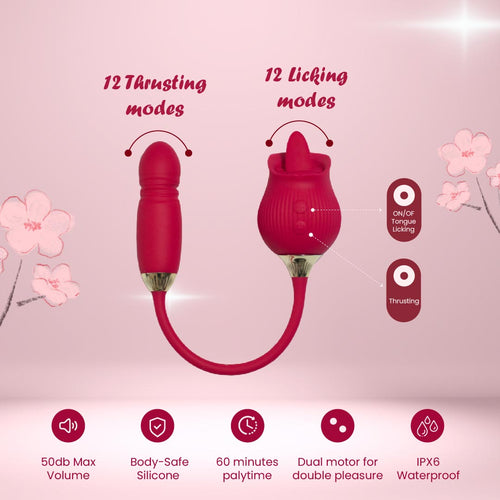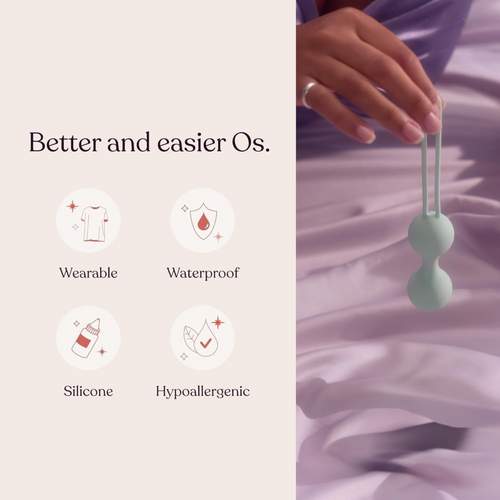
How Important Is Sex to a Woman?
Ever wonder why some women seem completely unbothered by dry spells while others consider intimacy non-negotiable? The truth about female sexuality isn't what magazines have been telling you for decades.
I've spent 15 years researching how important sex is to a woman's overall well-being, and the answers might surprise even the most "sexually enlightened" among us.
Sex means different things to different women at different life stages—sometimes it's about connection, sometimes pleasure, sometimes neither. What matters isn't frequency but understanding your unique relationship with intimacy.
But here's what nobody's talking about: the invisible factors that shape female desire more powerfully than any bedroom technique ever could. And they have nothing to do with what you think.
Understanding Female Sexual Health and Satisfaction
The Physical Components of Sexual Well-being
Sex isn't just about what happens between the sheets. For women, sexual health encompasses a complex interplay of physical systems. Hormones like estrogen and testosterone significantly impact desire and arousal, while blood flow to the genital area enables physical response.
When everything's working in harmony, a woman's body responds through:
-
Increased sensitivity in erogenous zones
-
Natural lubrication
-
Engorgement of genital tissues
-
Possibility of orgasm through various types of stimulation
Many women don't realize that general health directly affects sexual function. Poor sleep, chronic stress, and certain medications can dampen desire faster than an awkward comment from your partner. Regular exercise boosts blood flow and mood—both crucial for a satisfying sex life.
Emotional Dimensions of Sexual Fulfillment
The brain truly is the most powerful sexual organ. For many women, emotional connection forms the foundation of sexual satisfaction. Trust, safety, and emotional intimacy often precede physical desire.
A woman's sexual experience typically involves:
-
Mental presence and engagement
-
Emotional connection with partner(s)
-
Freedom from judgment and performance pressure
-
Space for vulnerability and authentic expression
Stress, relationship conflicts, and past traumas can create significant barriers to enjoyment. Women who report the highest sexual satisfaction generally describe feeling respected, desired, and emotionally secure with their partners.
The Myth of Universal Sexual Desire
The biggest misconception? That all women should want sex at the same frequency or intensity. Sexual desire exists on a spectrum, and there's no "normal" level that applies to everyone.
Some women experience spontaneous desire—sexual thoughts that appear seemingly unprompted. Others primarily feel responsive desire—arousal that develops after physical or emotional stimulation begins. Neither is better or healthier.
Asexuality and naturally lower libido are valid variations of human sexuality, not problems to be fixed. The issue isn't how much desire a woman feels, but whether her experience aligns with her personal values and relationship needs.
How Sexual Needs Evolve Throughout Life
Women's sexual needs and responses transform throughout their lives. Puberty brings hormone surges and new bodily awareness. Pregnancy, childbirth, and postpartum periods often require sexual adjustments as bodies and priorities shift.
Perimenopause and menopause bring significant hormonal changes that can affect:
-
Natural lubrication
-
Tissue sensitivity
-
Time needed for arousal
-
Intensity of orgasm
But contrary to outdated beliefs, many women report their most satisfying sexual experiences in midlife and beyond. With age often comes improved communication skills, greater self-knowledge, and freedom from unwanted pregnancy concerns.
Throughout these transitions, a woman's relationship with sex may shift from procreation-focused to pleasure-centered to intimacy-driven—or follow an entirely different path. The common thread? Authentic sexual expression that honors her current needs and circumstances.
The Psychology Behind Female Sexual Desire
Differentiating Between Spontaneous and Responsive Desire
Women's sexual desire isn't one-size-fits-all. For years, we misunderstood how female arousal works because we applied the male model to everyone. Big mistake.
Here's the truth: many women experience responsive rather than spontaneous desire. What's the difference?
Spontaneous desire feels like a lightning bolt—it hits you out of nowhere. You suddenly want sex without any particular trigger. This is what most people think of as "normal" desire.
Responsive desire is different. It builds after sexual stimulation begins. You might not feel "in the mood" initially, but with the right touch, emotional connection, or environment, desire grows.
Neither type is better or more "normal." About 75% of men primarily experience spontaneous desire, while women often report a mix, with responsive desire being more common.
Many women worry something's wrong when they don't feel random urges. They're waiting for that lightning bolt. But understanding that responsive desire is perfectly normal can be incredibly freeing.
The Role of Mental Connection in Sexual Satisfaction
For many women, the brain is the most powerful erogenous zone. That's not just a cute saying—it's backed by research.
Mental connection influences sexual satisfaction in profound ways:
-
Safety and trust create the foundation for pleasure
-
Emotional intimacy often amplifies physical sensations
-
Being truly seen and understood builds arousal
-
Mental presence (not thinking about tomorrow's meeting) intensifies orgasms
The oxytocin released during emotional bonding primes the body for sexual response. That's why meaningful conversation can be as arousing as physical touch for many women.
Women consistently report higher satisfaction when sex includes meaningful eye contact, verbal affirmation, and emotional vulnerability. The brain craves connection as much as the body craves touch.
How Stress and Mental Health Impact Sexual Desire
Stress is kryptonite for female sexual desire. When your brain is in survival mode, reproduction takes a backseat—biologically speaking, it's terrible timing to make babies when you're running from tigers.
Modern stressors might not be life-threatening, but your body doesn't know that. Work deadlines, family responsibilities, and financial worries trigger the same stress response as physical danger.
The impact is real:
-
Cortisol (the stress hormone) decreases testosterone, which drives desire in all genders
-
Anxiety makes it harder to stay present during intimacy
-
Depression dampens physical sensations and emotional responses
-
Medication side effects often include reduced libido
Interestingly, some women experience temporarily increased desire during moderate stress—the body's way of seeking comfort and connection. But chronic stress almost always diminishes sexual interest over time.
Breaking Free from Societal Expectations and Shame
Women's sexuality has been policed, judged, and misunderstood for centuries. The resulting shame creates invisible barriers to pleasure and desire.
The double standard persists: sexually expressive men are players; sexually expressive women face judgment. This cultural baggage follows women into the bedroom, making it harder to express authentic desire.
Common harmful messages women internalize:
-
"Good girls don't want/enjoy sex too much"
-
"Your pleasure is secondary to your partner's"
-
"Your body should look perfect during intimacy"
-
"You should orgasm quickly and dramatically"
Breaking free means questioning these beliefs. It means recognizing that female sexuality is naturally cyclical, responsive, and uniquely individual.
Many women report sexual awakening in their 30s and 40s—not because their bodies changed dramatically, but because they finally shed the shame that blocked their natural responses.
The most powerful aphrodisiac might simply be permission—permission to want what you want, to communicate it clearly, and to prioritize your pleasure without apology.
Physical Intimacy Beyond Intercourse
The Value of Non-Sexual Touch and Connection
Sex isn't just about intercourse. Far from it.
When we talk about intimacy between partners, there's this whole universe of connection that happens without anyone taking their clothes off. And honestly? This stuff matters just as much—sometimes even more.
Think about the last time someone you loved simply held your hand. Or when they gave you a long hug after a terrible day. That warmth spreading through your chest wasn't just nice—it was your body responding to one of our most basic human needs: physical touch.
For many women, these moments of connection create the foundation for sexual desire. A partner who touches you throughout the day—a hand on your lower back while passing in the kitchen, playing with your hair while watching TV, or a genuine kiss goodbye that lasts more than half a second—is building intimacy constantly.
Science backs this up too. When we experience affectionate touch, our bodies release oxytocin (yep, the famous "cuddle hormone"). This powerful chemical reduces stress, increases trust, and strengthens emotional bonds between partners.
Alternative Forms of Intimacy That Build Satisfaction
Physical connection exists on a spectrum, and exploring it fully can revolutionize your relationship satisfaction.
Many couples fall into a binary thinking trap: either we're having sex or we're not being intimate. This misses all the delicious middle ground where so much connection happens.
Consider these intimate activities that don't involve intercourse but can create profound connection:
-
Sensual massage without the expectation it leads to sex
-
Taking a shower or bath together
-
Slow dancing in your living room
-
Lying intertwined while talking about your day
-
Playful physical touch like tickling or wrestling
These activities engage your senses, promote vulnerability, and create shared experiences that strengthen your bond. For many women, this kind of physical intimacy satisfies deep emotional needs that intercourse alone simply can't.
What's particularly powerful is how these forms of connection often create a feedback loop in relationships. The more secure and connected you feel emotionally, the more open you become to sexual exploration. And vice versa.
Creating Space for Sexual Exploration and Communication
The bridge between non-sexual touch and fulfilling sexual experiences is honest communication. But let's be real—talking about what you want in bed isn't always easy.
Start small. Instead of a formal sit-down conversation (which can feel intimidating), try communicating during those alternative intimacy moments we just discussed. When you're already physically connected, it's often easier to share what feels good.
Try questions like:
-
"I love when you touch me like that. What feels good when I touch you?"
-
"What kind of touch makes you feel most connected to me?"
-
"I'd love to try [specific activity]. How does that sound to you?"
Creating a judgment-free zone is crucial. Many women report that fear of criticism prevents them from expressing their desires. Agree with your partner that curiosity, not judgment, will guide your conversations.
Remember that exploration is about the journey, not reaching some predetermined destination. Removing goal-oriented thinking (especially around orgasm) creates space for discovery that can transform your intimate life.
Physical intimacy exists in countless forms, and each offers unique benefits. When partners recognize this full spectrum of connection, they often discover that their relationship becomes richer, more satisfying, and yes—often leads to better sex too.
Communication as the Foundation of Sexual Satisfaction
A. Expressing Needs Without Fear or Judgment
Ever notice how hard it is to say what you really want in bed? Many women struggle with this. They worry about being judged, rejected, or making their partner feel inadequate.
But here's the truth: your sexual needs matter. They're not "too much" or "weird" or "selfish." They're just yours.
Starting these conversations gets easier with practice. Try phrases like "I really enjoy when you..." or "I'd love to explore..." instead of "You never..." or "You always..."
The bedroom isn't a place for scorekeeping. It's where you both get to be vulnerable and real.
B. Active Listening and Empathetic Response
Active listening isn't just nodding while waiting for your turn to talk. It's about truly hearing your partner.
When she opens up about her desires, don't immediately:
-
Get defensive
-
Compare her to exes
-
Make jokes to lighten the mood
-
Rush to solutions
Instead, try:
-
Asking follow-up questions
-
Reflecting back what you heard
-
Validating her feelings
-
Expressing appreciation for her honesty
Your response shapes whether she'll feel safe sharing again. A dismissive comment can shut down intimacy for months.
C. Navigating Differences in Sexual Desire
Mismatched libidos happen in practically every relationship at some point. One of you wants sex daily, the other is good with once a week. One craves morning intimacy, the other comes alive at night.
These differences aren't character flaws. They're just differences.
What doesn't work: pressuring, guilting, or keeping score.
What does work:
-
Scheduling intimate time (not just sex)
-
Finding compromise frequencies
-
Expanding your definition of "sex"
-
Understanding each other's arousal patterns
Sometimes the lower-desire partner feels broken. Sometimes the higher-desire partner feels rejected. Both experiences are valid and deserve compassion.
D. Building Trust Through Honest Conversation
Trust isn't built in grand gestures. It grows in small moments of vulnerability met with care.
Sexual trust develops when:
-
You keep private things private
-
You respect boundaries without pouting
-
You follow through on promises
-
You admit mistakes
-
You prioritize mutual pleasure
-
You stay curious rather than assuming
Many women report that deep trust allows them to be more sexually adventurous and present. When worry about judgment disappears, pleasure has room to expand.
The most intimate conversations often happen outside the bedroom, when clothes are on and pressure is off. A quiet evening chat might be the gateway to the most fulfilling sexual connection you've ever experienced.
Factors That Influence Female Sexual Satisfaction
Factors That Influence Female Sexual Satisfaction
A. Hormonal Fluctuations and Their Impact
Women's hormones are like backstage crew members at a concert - you don't see them, but they're calling major shots. Estrogen, progesterone, and testosterone levels don't just stay put; they dance around throughout the month, affecting desire in ways that can feel unpredictable.
During ovulation, many women experience a natural surge in libido - nature's way of saying "now would be a great time to make a baby!" Then there's the week before your period when progesterone takes over, and suddenly Netflix seems way more appealing than sex.
Birth control can throw another wrench in the works. While it provides freedom from pregnancy worries, many women report decreased desire as a frustrating side effect.
The takeaway? If your interest in sex seems to rise and fall like the tide, you're not imagining things. Your hormones are real players in your sexual satisfaction.
B. Life Transitions: Pregnancy, Menopause, and Beyond
Pregnancy transforms your body in countless ways, and your sex drive isn't immune. Some women feel their libido skyrocket during the second trimester when increased blood flow enhances sensitivity. Others feel about as sexy as a beached whale throughout the entire nine months.
Postpartum brings its own challenges. Between healing tissues, sleep deprivation, and constantly having a tiny human attached to you, desire often takes a backseat. And that's completely normal.
Menopause marks another significant shift. As estrogen levels decline, many women experience vaginal dryness and decreased sensitivity. But here's what nobody tells you: plenty of women report feeling more sexually free after menopause. Without pregnancy concerns and with grown kids, they discover new dimensions of pleasure.
These transitions don't have to spell doom for your sex life. Understanding what's happening physiologically helps navigate the changes with compassion for yourself.
C. The Connection Between Body Image and Sexual Confidence
It's tough to feel sexy when you're busy cataloging every perceived flaw in your body. Research consistently shows that women who feel comfortable in their skin report greater sexual satisfaction - regardless of their actual size or shape.
When you're constantly worried about how your thighs look or whether your partner notices your stomach, you're not present. And presence is essential for pleasure.
Body confidence isn't about meeting some external standard. It's about appreciation for what your body can do and feel. Women who cultivate a positive relationship with their bodies - focusing on sensation and pleasure rather than appearance - typically enjoy sex more.
Sexual confidence grows from self-acceptance. Easier said than done in our airbrushed world, but prioritizing how you feel over how you look can transform your experience.
D. How Past Experiences Shape Current Sexual Attitudes
Our sexual histories don't just disappear; they become part of our sexual DNA. Positive early experiences often pave the way for continued enjoyment, while negative ones can cast long shadows.
Women who experienced shame around sexuality growing up might struggle to fully embrace pleasure as adults. Religious messaging, family attitudes, and cultural norms all leave their mark on how comfortable we feel expressing desire.
Past trauma deserves special mention. Sexual assault or coercion can create complex barriers to satisfaction that may require professional support to address. The brain establishes protective patterns that can be difficult to unwind without help.
Your history doesn't determine your sexual future, but acknowledging its influence helps make sense of current patterns and opens doors to new possibilities.
E. Finding Balance in Busy Lives
Sex requires something increasingly rare in modern life: unscheduled time. Between careers, childcare, household management, and social obligations, many women find themselves permanently exhausted.
Sexual satisfaction often hinges on having enough mental bandwidth to actually want sex. When you're carrying the mental load of remembering dentist appointments, work deadlines, and what's for dinner, desire struggles to find space.
Some couples swear by scheduled sex, which sounds about as sexy as a dental cleaning until you try it. Having it on the calendar creates anticipation and ensures it doesn't get lost in the shuffle of daily life.
Boundaries around technology help too. Nothing kills mood faster than notification pings or the glow of a phone screen. Creating phone-free zones and times signals that connection matters.
Quality often trumps quantity. One deeply satisfying encounter can sustain intimacy better than several rushed, distracted attempts.
Creating a Fulfilling Sexual Relationship
Prioritizing Quality Over Quantity
Sex isn't a numbers game. Think about it - would you rather have mind-blowing, connected sex once a week or mediocre, going-through-the-motions sex every day? For most women, the answer is obvious.
Quality sexual experiences create deeper bonds than frequent but unsatisfying encounters. When partners focus on meaningful connection rather than "checking a box," both people tend to feel more fulfilled.
What makes for quality? It's different for everyone, but usually includes:
-
Feeling truly desired (not just convenient)
-
Emotional presence from both partners
-
Time for arousal and pleasure
-
Communication during intimacy
-
Aftercare and connection following sex
Remember that a single incredible night can fuel a woman's satisfaction for days, while multiple disconnected encounters might leave her feeling empty.
Addressing Mismatched Libidos With Compassion
Almost every couple faces desire discrepancies at some point. One partner wants sex more often than the other - and contrary to stereotypes, women are just as likely to be the higher-desire partner.
The key is handling these differences without shame or pressure. When we approach mismatched libidos with curiosity instead of judgment, we create space for honest conversation.
Try asking:
-
"What makes you feel most in the mood?"
-
"What times of day do you feel most energetic?"
-
"Are there types of intimacy you'd enjoy when full sex isn't appealing?"
Sometimes the solution isn't meeting exactly in the middle, but finding creative compromises. Maybe it's scheduling intimacy (which can build anticipation), exploring non-penetrative options, or supporting solo pleasure.
The Importance of Mutual Pleasure and Reciprocity
Sex should feel good for everyone involved - period. Yet many women have experienced one-sided encounters where their pleasure was an afterthought.
True reciprocity isn't about keeping score. It's about genuine investment in your partner's experience. When both people approach sex with the attitude of "your pleasure excites me," everything changes.
Some practical ways to build reciprocity:
-
Take turns focusing completely on one partner's pleasure
-
Ask specific questions about what feels good
-
Notice and celebrate your partner's responses
-
Share fantasies and desires without judgment
-
Be willing to teach and learn
Women often report that feeling truly seen during intimacy matters more than any specific technique.
Building a Sexual Connection That Evolves With Time
Long-term sexual relationships face a unique challenge: familiarity. The excitement of novelty naturally fades, but something deeper and more meaningful can take its place.
An evolving sexual connection requires intentionality. Bodies change. Desires shift. Life circumstances transform. The couples who maintain fulfilling sex lives over decades are those who embrace these changes rather than fighting them.
Try approaching your sexual relationship as a living thing that needs regular nourishment:
-
Share new experiences outside the bedroom
-
Revisit conversations about desires regularly
-
Introduce elements of novelty and surprise
-
Appreciate the comfort and safety of knowing each other deeply
-
Celebrate the unique history you share
Remember that aging brings wisdom about pleasure. Many women report their most satisfying sexual experiences come later in life, when they truly know themselves and can communicate their needs clearly.
Conclusion
Sexual satisfaction plays a vital role in a woman's overall wellbeing, but it's deeply personal and varies significantly from one individual to another. Throughout this exploration of female sexuality, we've discovered that sexual health encompasses physical, psychological, and emotional dimensions that work together to create fulfilling experiences. Communication remains the cornerstone of sexual satisfaction, allowing partners to express desires, boundaries, and needs openly and without judgment.
Creating a truly fulfilling sexual relationship requires ongoing effort, understanding, and adaptation. It means recognizing that intimacy extends beyond physical intercourse to include emotional connection, trust, and mutual respect. Whether sex holds high importance or moderate significance in a woman's life depends on her unique preferences, life circumstances, and relationship dynamics. The key is fostering an environment where each person feels valued, heard, and empowered to explore their sexuality in ways that bring genuine satisfaction and joy.












